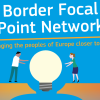By Alessia Setti, PhD candidate in Political Science at University of Lausanne and Youth4Cooperation Cross-Border Ambassador
In Europe, some national boundaries are still visible and tangible. One can picture natural borders, such as the Rhine between France and Germany, or customs controls between Switzerland and its neighbouring countries. Yet there is another border that is more difficult to visualise, but just as present: the language barrier.
Cross-border populations across Europe that do not speak the same language face an enormous cross-border obstacle. Language is a means of communication and, when shared, can bring different communities closer. Therefore, language differences may have repercussions on the quality and frequency of cross-border relations both among citizens and political authorities.
Survey data gathered through the 2020 EU cross-border cooperation survey enables us to, firstly, grasp border citizens’ impressions regarding language differences and, secondly, explore the relationship between this cross-border obstacle and cross-border mobility. First, 53% of respondents living in border regions across Europe stated that language differences constitute a problem – being it major or minor – for cross-border cooperation in their Interreg A programme area (see Figure 1).

Second, understanding the impact of such language differences on actual cross-border relations is key to designing tailored policies. The survey results allow one to hypothesise some first relations, although no clear-cut causal effect can be detected at this stage. Let’s consider those cross-border activities that, on a general level, require a certain knowledge of the language spoken in the neighbouring region. Four types of cross-border mobility stand out as relevant among those scrutinised in the said survey: a) to visit family members; b) to visit friends; c) to use public services (e.g. education services); d) for work/business purposes. Interestingly, survey data points out an association between language as a barrier and low levels of cross-border mobility. Specifically, language difference is negatively correlated with the frequency of cross-border mobility for each of the four above-mentioned cases.
Put differently, the more language differences are considered a barrier, the less frequently people cross the border. The most evident example is the one concerning cross-border travels to meet friends; cross-border regions whose citizens largely perceive linguistic diversity as a problem are those with lower levels of mobility for this specific reason (see Figure 2).

This overview does not provide a causal explanation of the effects of language barriers on cross-border cooperation. Nevertheless, it illustrates that most citizens of border regions perceive linguistic diversity in cross-border regions as an obstacle to cross-border cooperation. Moreover, a comparison with other survey answers paves the way for discussion on the potential impact of language differences on cross-border relations, notably in terms of social interactions.
Addressing this cross-border obstacle may be a long-term commitment and investment, yet it is not unfeasible. One solution would be to dedicate a specific budget towards language courses and exchanges under Interreg funding and/or within European Groupings for Territorial Cooperation. Another initiative would be the promotion of multilingual teaching in border regions. English language has become a common means of communication, but it may not be sufficient for successful cross-border cooperation in Europe.
Note: Reported data refers to author’s elaborations based on raw data from the 2020 EU cross-border cooperation survey. A list of correspondence between cross-border regions’ codes and full names of Interreg programmes can be found here.
- Za objavu komentara morate se prijaviti
Komentari
Dear Alessia,
Thank you for this very insightful article.
- Za objavu komentara morate se prijaviti

